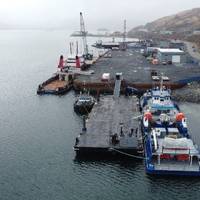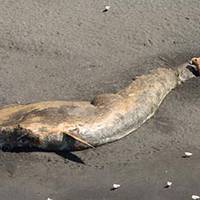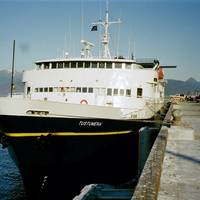New Maritime Response Center to Serve Alaska's Pacific Rim

Kodiak is now home to the Pacific Rim Response Center (PRRC), a facility that serves as a hub for a comprehensive suite of maritime resources providing vessel support, marine casualty response, and oil and hazardous spill response. The PRRC was established as a collaboration between Paradigm Marine and strategic partners Alaska Chadux̂ Network (Chadux̂) and Global Diving & Salvage (Global), providing one consolidated location for a range of resources to serve the Western Alaska maritime industry.With personnel and assets staged in Kodiak…
NOAA Declares Whale Deaths an ‘Unusual Morality Event’

The U.S. National Oceanic and Atmospheric Administration (NOAA) has declared the recent deaths of 30 large whales in the western Gulf of Alaska an "unusual mortality event," triggering a focused, expert investigation into the cause. An unusual mortality event is a stranding event that is unexpected, involves a significant die-off of a marine mammal population and demands immediate response. Since May 2015, 11 fin whales, 14 humpback whales, one gray whale and four unidentified…
Alaska Ocean-going Ferry Project: Seattle Consultants Chosen

Naval engineering firm Glosten and Associates of Seattle will guide the state as it plans a new ocean-going ferry to replace the 49-year-old ferry Tustumena, reports the 'Kodiak Daily Mirror', citing news from a meeting of the state's ferry advisory board in Anchorage. The state is prepared to spend up to $10 million designing the Tustumena, money that has been reserved from the state's vessel replacement fund. The design study report will recommend a particular vessel design, and the state may proceed with procurement at that point.
Polar Petroleum Appoints ARCO Alaska Veteran
Polar Petroleum Corp. appointed Mr. Donald W. Brizzolara to the Company's Advisory Board as Chief Geological Advisor. Mr. Brizzolara represents 25 years of experience in oil and gas exploration and development, geology and consulting experience for firms such as ConocoPhillips and Shell. Of particular importance to the Company, Mr. Brizzolara's background includes work on the Prudhoe and Kuparuk fields, which, together constitute the majority of the oil production on the North Slope (51% and 20%, respectively). Polar Petroleum's Hemi Springs Project is spread along the southwestern border of the Prudhoe Bay Unit, and lies to the southeast of the Kuparuk River Unit. Donald W.
NOAA’s Coast Survey Plans for New Arctic Nautical Charts

Less sea ice and more ship traffic means new charts needed for safety. NOAA’s Office of Coast Survey has issued an updated Arctic Nautical Charting Plan, as a major effort to improve inadequate chart coverage for Arctic areas experiencing increasing vessel traffic due to ice diminishment. The update came after consultations with maritime interests and the public, as well as with other federal, state, and local agencies. “As multi-year sea ice continues to disappear, vessel traffic in the Arctic is on the rise,” said Rear Admiral Gerd Glang, NOAA Coast Survey director.
Arctic Nautical Charts: NOAA Plans Updates

Less sea ice and more ship traffic means new charts needed for safety. NOAA’s Office of Coast Survey has issued an updated Arctic Nautical Charting Plan , as a major effort to improve inadequate chart coverage for Arctic areas experiencing increasing vessel traffic due to ice diminishment. NOAA plans to create 14 new charts to complement the existing chart coverage. For example, seven of the charts will complete chart coverage from the Alaska Peninsula to Cape Lisburne at the edge of the North Slope…
This Day in Coast Guard History – March 15
1942- The 172-foot tender CGC Acacia was en route from Curacao, Netherlands West Indies to Antigua, British West Indies, when she was sunk by shellfire from the German submarine U-161. The entire crew of Acacia was rescued. She was the only Coast Guard buoy tender sunk by enemy action during the war. 1944- Coast Guardsmen participated in the invasions of Manus (Admiralties) and Emirau (St. Mathias Islands). 1946- For the first time, U.S. Coast Guard aircraft supplemented the work of the Coast Guard patrol vessels of the International Ice Patrol, scouting for ice and determining the limits of the ice fields from the air. 1983- The Coast Guard retired its last HC-131A Samaritan. 1991-The F/V Alaskan Monarch became trapped in the ice-encrusted Bering Sea near St.
Kvichak Delivers Law Enforcement
The deployment of catamarans as law enforcement patrol vessels has become a trend among the U.S. patrol agencies. The Alaska Department of Public Safety (ADPS) recently joined this trend by taking delivery of a 65 x 25 ft. aluminum catamaran, the Cama'i. Constructed by Kvichak Marine Industries and designed by Crowther Multihulls, the Cam'i is scheduled to patrol the waters around Kodiak Island, the Alaska Peninsula and Bristol Bay. According to Captain Al Cain of ADPS, research shows that catamarans offers a safe, stable work platform in the open seas, this along with increased fuel efficiency and increased usable deck space are factors for choosing the catamaran for the new patrol vessel. ADPS requires a top speed of approximately 25 knots and a cruising speed of 20 knots.
News: Kvichak Delivers Cama'i, Awarded Contract
Kvichak Marine Industries has delivered the Cama'i, a 69 x 25-ft. aluminum catamaran to the Department of Public Safety Division of Alaska State Troopers. Designed by Crowther Multihulls, the Cama'i is scheduled to patrol the waters around Kodiak Island, the Alaska Peninsula and Bristol Bay. The State Trooper mission requires a vessel with a top speed of 25 knots and a cruising speed of 20 knots. These speeds are attained by the propulsion choice of twin Caterpillar 3196 engines 660 bhp at 2300 rpm, driving 30-in. propellers through Twin Disc MG 5114A marine gears. The Cama'i will be used for protection of life and property, enforcement of commercial fishing regulations, search and rescue missions, and support of multi-agency law enforcement efforts.
President Lifts Ban on Bristol Bay Offshore Exploration and Drilling
The Bush administration recently announced that it has lifted a ban on offshore oil drilling in Bristol Bay, Alaska. The move is a shot in the arm for the Alaska oil and gas industry, which is hoping for approval to build a new natural gas pipeline. A recently elected oil-friendly governor, the pipeline project and now expanded offshore drilling possibilities mean increased demand for workers. On January 9, 2007, the Bush administration lifted a long-standing moratorium on oil exploration in a 5.6 million acre area in the North Aleutian Basin of Alaska's Bristol Bay region. New Alaska Governor Sarah Palin welcomed the news that the moratorium has been lifted.
Markets:Eyes and Ears on the Water
Since the 9/11 attack there has obviously been increased emphasis on getting more eyes, ears and in some cases firepower on America's ports and inland waterways. Homeland security has become a top priority for the U.S. Coast Guard and numerous other Federal, state and local agencies. Patrol boats offer a relatively low cost solution to increasing security on America's waterways and in and around ports. These vessels range from RIB's with outboard motors to aluminum-hulled craft with high horsepower diesel engines enabling them to quickly reach and maintain high speeds often required for interdiction. Fortunately America was building capable patrol boats before 9/11. The mission of these vessels prior to 9/11 was mostly drug interdiction, search and rescue and/or border security.







